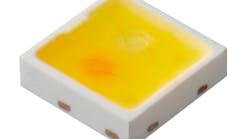In 2002 Korea consumed 278 TWh of electricity at a cost of $20 billion. More than 20% of this energy was used for lighting. According to Yu, if LEDs achieved complete penetration of the lighting market they would reduce the national power demand by the output equivalent of three nuclear power stations. "The Korean government wants to [adhere to] environmental pollution agreements," added Yu, who points out that reducing Korea's energy requirements would help to decrease carbon dioxide emissions and allow the country to meet targets set by the Kyoto Protocol. Yu also notes that an increased dependence on LED-based lighting would reduce the use of glass, phosphors and heavy metals, and would help adherence to new environmental regulations coming into force on July 1, 2006.
Korea's LED industry has evolved in three stages. Early research and development was undertaken by LG and Samsung, the two domestic companies that continue to dominate Korea's consumer electronics industry and LED efforts, along with several universities and a program organized by the Korea Research Institute for Standards and Science that ran from 1993 to 1996. A business phase followed between 1999 and 2000, with several firms funded though venture capital and initial production runs at LG and Samsung.
The current activation phase, which began in 2001, has seen the number of companies involved in the LED industry rise to more than 340. This has provided Korea with a research and development manpower of about 1000 for the III-nitride industry alone. Key research topics now include high-efficiency and high-reliability devices, UV-LEDs, GaN on silicon and other non-sapphire substrates, ZnO LEDs, high-power packaging and modules, and phosphors for blue LEDs.
KOPTI is central to much of the current development. The government-backed organization is located in Gwangju, in south-west Korea, and is devoted to the development of the photonics industry. Its roles are to help commercialize basic and applied photonics technologies, to build an advanced technology infrastructure and to implement a comprehensive industrial support system.
Housed in a 35,640 m2 building that includes a 1789 m2 cleanroom, KOPTI owns 384 pieces of equipment that have a combined value of $65 million, and has access to funding of $20 million each year. It employs 70 PhD-educated staff, a number that will rise to 150 in 2008. Its facilities cover all aspects of LED production, from InP, GaAs and GaN epitaxial growth on 2 to 4 inch substrates, through materials characterization and various processing stages, to packaging and performance and reliability testing. The national government meets 73.1% of KOPTI's costs, with Gwangju city (16.5%) and industry (10.4%) making up the remainder.
Korea's LED infrastructure is now benefiting from the launch of a national program for the display industry, in which Samsung and LG are big players internationally. This program covers development of LCDs, electronic paper and organic electroluminescence, and runs from 2004 to 2008. In Gwangju, which is also known as the "city of light", a mixture of national and local government and private-sector investment has been funding LED development since 2000.
Through the so-called LED Valley project, the region will also receive $100 million between 2005 and 2008 toward high-brightness (HB) LED development. This initiative will involve the construction of 310,000 m2 of building space, while a solid-state lighting and display center with research and development support will also be established.
Gwangju is also set to receive a further $430 million over the next four years, which will be split between the second phase of a photonics industry project investigating HB-LEDs and a venture to deploy fiber-to-the-home networks to 20,000 households.
With all this funding in place, Yu predicts that the larger companies will first look to penetrate television-backlighting application markets in 2006, before re-focusing efforts on external car lighting in 2008. Domestic lighting applications are expected to follow at the end of the decade. The smaller companies will concentrate on municipal lighting applications, such as the illumination of bridges, roadsides and other public spaces.
• This article originally appeared in the April issue of Compound Semiconductor magazine.




